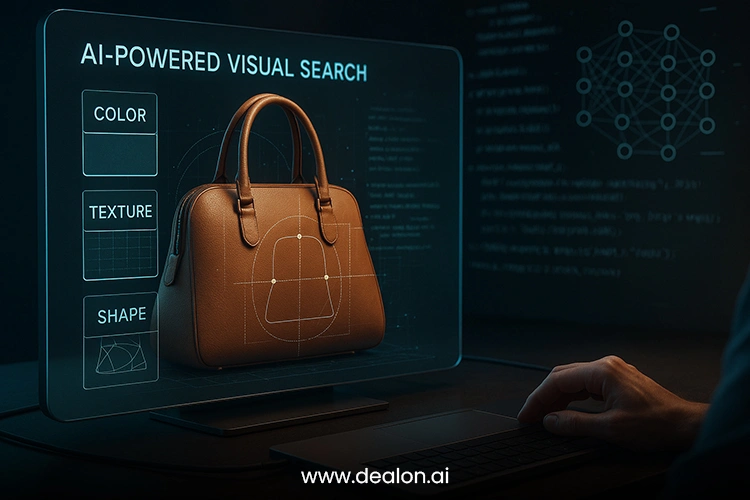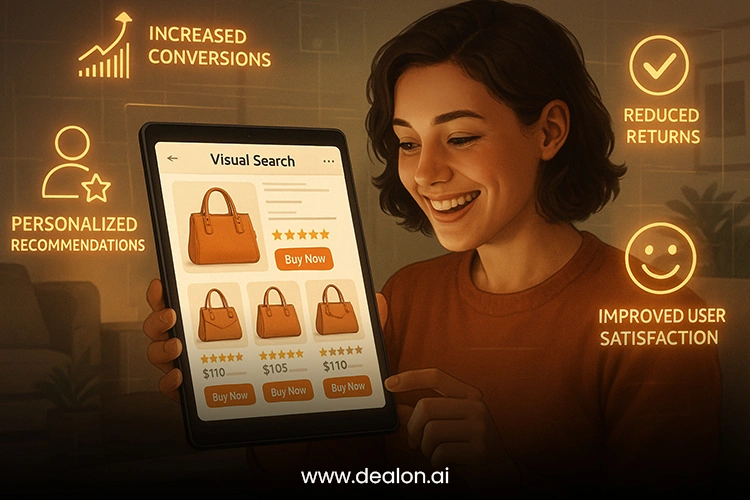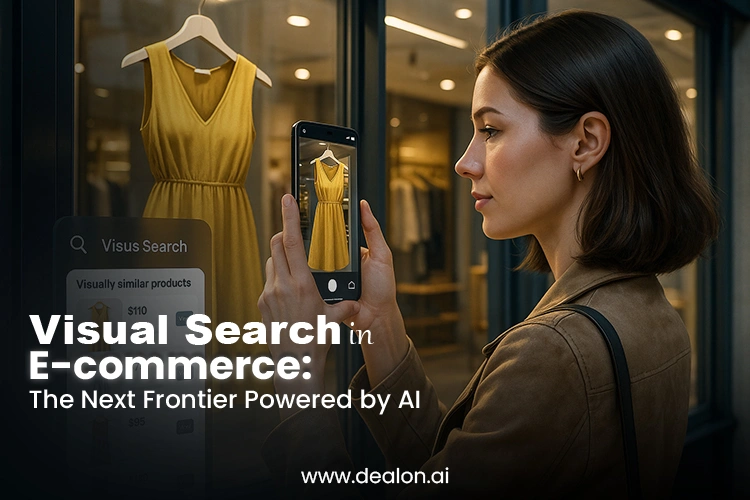The world of e-commerce is competitive, and in order to thrive in it, innovation is the most crucial element of beating the competition and providing outstanding customer experiences. Visual search technology is one of the most radical innovations that are actively changing the field of digital retail at the moment, and it is this phenomenon that is guided by the powerful force of Artificial Intelligence.
The good old days when consumers were forced to use the constraints of text queries to locate products were long forgotten. Visual search would lead to a new way of doing things since customers would use images, whether social media snapshots, other advertisements, and other photos that customers have in their collections, as their primary tool to search and buy. This paradigm shift does not only seem convenient, but it is a revolution in the way business deals with consumers within the online market side.
The fundamental element of this innovation is the incorporation of computer vision and machine learning codes, invented to allow e-commerce websites to work out and handle visual information at a previously unavailable scale and precision. Retailers would be able to align their products to the pictures that are uploaded by customers with the help of these sets of artificial intelligence, providing highly relevant results that go in the same line as the picture sought in terms of style, color, and texture. The same intuitive solution does not only provide consumers with better shopping but also a more personal, efficient, and involving shopping method.
With businesses scrambling to adopt visual search on their platforms, it is becoming more clear how customer satisfaction can boost, rates of conversion can get a boost, and the rate of returns can decrease. Yet, at the same time, visual search remains in its immature phase in spite of its transformative potential. As the technology matures, it is expected to create new avenues of innovation, and this is an excellent way through which brands can establish closer relationships with customers. In this blog, we discuss how the feature of visual search that is driven by AI is creating a platform for the new frontier of e-commerce.
Also Read: How AI is Revolutionizing Content Calendar Planning for Marketers
What is E-Commerce visual search?

Visual search is a new and cutting-edge technology powered by artificial intelligence, which is fundamentally inverting the experience consumers have with e-commerce sites. In contrast to the traditional search, where the idea is based on using written keywords, in visual search, one can search products based on a single picture. Using the potential of artificial intelligence, machine learning, and computer vision, visual searching technologies recognize the contents of the image, including color, shape, texture, and patterns, to define and find visually similar goods in online retail where the visual images belong.
Such an approach to searching based on visual samples is far more advanced than the possible data obtained by using keyword-based queries that offer a more simplistic and convenient approach to shopping. An image of fashion, furniture, or jewelry will let shoppers discover similar products by simply uploading it online. This connects offline and online shopping, making it simple for consumers to locate similar or complementary products. Rather than wasting time to trace out specific keywords, users are in a position to find the right products based on visual impressions that appeal to their needs and preferences.
The visual search uses AI-based algorithms and is based on learning the more people interact, the more the search precision increases, and the better the results are refined to the benefit of the user. That is, the machine learning models become better every time the consumers post additional pictures, providing even more precise and personalized results. This increase in functionality combined with the subjectively sensed surroundings makes this technology not only capable of matching the visual characteristics but also capable of perceiving the context, e.g., suggestion of season products and suggestions based on the history of the customer’s preferences.
To e-commerce companies, this invention creates the potential for hyper-personalization of the experience, which in turn will maximize user engagement and conversion rates and minimize returns. Through visual search, the experience of a consumer is given a new face, and it is no longer a transactional one, but it becomes an interactive, smooth, and very customized shopping experience. Visual search certainly will be a significant aid to e-commerce when dealing with artificial intelligence in the future since its convenience and precision are beyond compare.
The AI in Visual Search Technology

The key behind visual search technology is that of Artificial Intelligence, more so, computer vision that allows machines to process and interpret images in the same manner as humans themselves. Examples of ground-breaking artificial intelligence include transforming the e-commerce industry through automated product discoveries, where a consumer can search the products using an image instead of utilizing keywords. A traditional visual search is made fast and efficient with the help of artificial intelligence: with the help of a complex set of algorithms, machine learning, and deep neural networks, it becomes possible. This is a more detailed explanation of how AI powers this technology and revolutionizes the process of online shopping.
1. Image Recognition: Deconstruction of the Visual
Image recognition is the initial part of the visual search. AI algorithms start working with the image analyzed when a user posts some pictures by breaking it down into the elements. Some of the features that are usually found among these components include color, texture, shape, and patterns. These locations or data points of the image are captured by artificial intelligence using thoughtful image processing algorithms, and these are then the follow-up data points in recognition of objects in the picture.
The training process of AI models is done on large details of image data, thereby allowing these models to gauge even the finest differences in visual content. As an example, the system will be able to distinguish between different materials, leather, fabric, and metal, through the texture and the pattern. Mapping these data points to a comparative and large data set of known objects, artificial intelligence reproduces the human capability to identify and perceive images in the search process, and, as a result, the process becomes natural and not intimidating.
2. Feature Matching Feature Matching: Image to Product
Once the image has been analyzed and features have been identified, the next stage of an AI is carried out, that of feature matching. The stage is known as a visual comparison of the attributes of the uploaded image to those present in the product catalog maintained by the retailer. A myriad of features is identified/identified based on scanning the whole database, which is then cross-checked with each other to find items that are visually similar to the input. The matching of features is not all about matching the same images. The AI is capable of discerning various comparable aesthetic features in multiple merchandises.
As an example, when a user uploads a photo of some pair of shoes, the artificial intelligence does not just search replica of these shoes. Instead, it finds characteristics of particular importance, like the silhouette of the shoe, the type of heel, the color, and the material, and then compares to that set of characteristics the ones that exist in the catalog. It is also much faster compared to the traditional text-based search and provides more precise results since it does not aim at searching by specific text-based metadata but by visual factors instead.
3. Machine Learning: Learning as it Goes Evolving
The most effective feature of AI in visual search is its learning capability, which has improved with time. This is because the more images the system processes and the more it interacts with the users, the brighter the system gets through the concept of machine learning. Every time a consumer uploads an image, the AI is taught by the preferences and actions and learns more about what would be deemed as appealing by the user.
This process of constant learning assists in making better search results. To take the example of an online clothing store, artificial intelligence may learn to focus on similar items whenever that specific user opens the online store. As time progresses, the AI will better understand what it is that a user seeks, thus ultimately presenting more personalized results that are applicable in context.
Artificial intelligence can also process complex situations; in this case, machine learning permits the model to process ambiguous images or detect objects that have different visual definitions by machine learning. This feature is particularly valuable to such industries as fashion, as trends and designs vary fast. Modern trends in e-commerce technology constantly keep AI-powered visual search in the lead, as it provides consumers with an ever-changing and developing shopping process, learning continuously based on new data.
4. The Contextual Relevance: Gaining Context into The Larger Picture
Although matching features and image recognition are paramount components, contextual relevance brings the aspect of visual search a notch higher. Higher-level artificial intelligence algorithms can comprehend the scenario in which an Empire picture can be used and use such knowledge in the results of the search. What this implies is that artificial intelligence does not need to be limited to distinguishing only visual elements like color and shapes; elements like season, taste, and brand can also be used.
To make an example, the AI does not merely compare the colors and texture of a leather jacket of the black color with other jackets of the dark shade made of leather. It will be able to evaluate the presence of any other contextual variables, e.g., whether the coat suits more winter fashion style, and even make a recommendation about the types of outfit that go along with it, i.e., scarves or boots, depending on the fashion trends. With the use of those nuances, artificial intelligence can present the search results not only visually similar but also contextually relevant, which makes the overall shopping experience better.
5. The next step in Multimodal Search
The future of visual search has been set to grow beyond image-only searches. As multimodal search grows, AI is more and more competent in integrating text and visual content to narrow down the search outcomes even further. An example may be provided by someone uploading a picture of a sofa and, at the same time, typing a description of a preferred style or color. The inputs can then be combined into more input by the artificial intelligence algorithms to give more specific and tailored recommendations on products. It is a hybrid search model that maximizes the capabilities of both natural language processing and image recognition, which makes it simple for the consumer to get what he is searching for.
Advantages of Visual Search to E-Commerce

Online shoppers are having an e-commerce experience as a result of visual search technology. Visual search can allow users to search products with the help of images rather than text-based searches and rely on artificial intelligence backed by machine learning and computer vision. This new generation of product discovery has various advantages for consumers as well as businesses.
An improved user experience is among the main advantages. Conventional methods of text-based search are annoying, but under visual search methodology, an image can be uploaded by a user, and he/she will be provided with the most needed information within seconds. It is a simplified action that makes shopping more natural and brings customer satisfaction and involvement, resulting in a longer time spent and, possibly, increasing conversion rates.
Visual search also offers a more customized shopper experience, only using recent searches, visit history, and user preferences to make recommendations. This is to increase customer satisfaction, create loyalty, and more upselling and cross-selling.
Moreover, visual search also increases the conversion rate by saving time on a decision and helps to find goods. It also enhances the reduction in returns by making sure that the products displayed to the viewership are precisely what the customers would want to buy, as this creates loyalty. Lastly, visual search is cross-device compatible, and this means that there is a constant shopping experience in mobile apps, websites, and social media apps, which is even more beneficial due to customer engagement.
E-Commerce Application of Visual Search
Visual search technology is revolutionizing different industries, making the shopping process more intelligent, time-consuming, and customized. The fashion industry is one of the major industries that is benefiting from this innovation. Companies such as ASOS, Zara, and Macy’s used visual search in order to enable their consumers to take photos and promptly discover comparable products. That would be especially useful in fashion, where the trends change rapidly, and consumers may locate similar products (to ones they saw on influencers or in social media) easily and quickly. Visual search takes you a step closer to doing something with it, as it generally promotes a more effective approach to shopping.
When it comes to the furniture and home decor industry, visual search is being implemented by retailers like Wayfair and Ikea to enable consumers to make decisions on the kind of furniture to buy based on the intended style. With the use of photos of anything they like as a piece, their customers could find something similar faster and, therefore, spend less time searching and be much more precise in their results than with the textual search.
Visual search helps the beauty and cosmetics industry as well; Sephora is a brand that enables people to take pictures and search for products available that match their skin or desired makeup style. It increases product discovery and customization and allows a consumer to easily mix and match to find the right look and be confident about what they are getting.
Conclusion
The world of e-commerce is being turned upside down (or right side up) with the visual search, which makes shopping more convenient, personalized, and efficient. Through the strength of artificial intelligence, machine learning, and computer vision, visual search facilitates browsing to consumers by simply uploading images, which removes the complications that come along with text-based searches. Besides making product discovery quicker and more straightforward, therefore leading to a better user experience, the technology also increases conversions and decreases the rate of returns due to more accurate and contextually well-documented results.
The fashion, home decor, and beauty industries are already reaping the revolutionary power of visual search and can already provide the customer with personalized product recommendation ideas that incorporate their unique style and preferences. Nevertheless, the technology is not without its struggles, especially when it comes to image recognition rate and security. These issues will decrease with the further development of artificial intelligence models being more potent and accurate.

